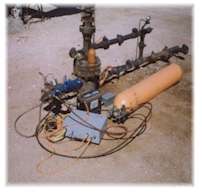<%
dim browserdetect, browser
Set browserdetect = Server.CreateObject("MSWC.BrowserType")
browser=browserdetect.Browser
%>
|
Providing Effective Pressure Transient Solutions
Introduction
Advances in pressure transient interpretation theory have driven exponential growth in measurement technology since the mid-sixties. During this period ARC Pressure Data has also grown as a provider of pressure transient testing services to meet the needs of energy producing companies. Over the years our emphasis on pressure transient testing has allowed us to excel in providing producing companies with effective test solutions.
|
Training
ARC’s wireline operators receive training specifically tailored for pressure transient testing services. They have been trained to conduct and monitor tests so that they meet the stringent test requirements of reservoir and production engineers.
Our operations and sales staff have years of experience with pressure transient testing. They have the knowledge and background necessary for setting up and planning successful well tests that will meet your testing needs. Our personnel are not merely “order takers” - they leverage their training and experience to help guide you through the job planning process.
|

|
|

|
Instrumentation
ARC has a wide range of instrumentation available for the measurement and acquisition of precision pressure data. ARC offers a selection of downhole memory gauges utilizing either strain or quartz transducer technology so that the optimal balance of price and gauge characteristics can be chosen.
In today’s mature fields a large majority of wells are on artificial lift – many of these are rod-pump systems. For these wells AWS (Automatic Well Sounder) technology often provides a very cost effective test option. It allows the calculation of bottomhole pressures without having to pull the rods and pump.
|
|
Surface pressure gauges can be utilized for the testing of many dry gas wells and water injection wells. Both strain gauge and quartz transducers are available for this purpose.
|

|
Deployment Methods
ARC offers a wide selection of gauge setting and deployment methods. These are well established, lower cost operations designed for use in production scenarios (cased hole, completed wells). Gauges are generally released downhole as opposed to “hanging on the wire”. The primary reasoning behind the practice of releasing gauges downhole is:
- Reduce the cost of surface equipment, such as wireline units, tied up for long periods,
- Provide a “secure” high pressure seal with master-valve shut-in’s on buildup tests,
- Provide a less hazardous method to acquire data in highly corrosive (H2S, CO2) environments by reducing wireline exposure time.
|
|
ARC employs the use of “soft-set” releasing tools to minimize the jarring of gauges that can occur with shear-off type tools. We have a selection of tools for releasing gauges in tubing and casing, as well as suspension on slickline.
|
Pressure Transient Test Types
ARC Pressure Data conducts all major types of pressure transient tests. These include the following:
- Single Rate Tests – buildups, falloffs, drawdowns
- Multi-Rate Tests – flow-after-flow, isochronal, modified isochronal, step-rate
- Multi-Well Tests – interference, pulse
- Specialized Tests – vertical interference, measurement while fracturing
|
Reporting
Test reports can be provided in hardcopy or electronic formats. A typical report consists of an operations log, flowing and static gradients, a data listing, and appropriate plots. This report is generally supplied in a hardcopy format but is also available in an Adobe Acrobat PDF file format. A data diskette (or other appropriate electronic media) is supplied that contains the complete dataset(s).
|

|
|
Quality Control
Pressure transient testing is comprised of more than just running gauges, acquiring data, and delivering test reports. An often-overlooked aspect of the test reporting process is that of quality control. It is during this phase that an in-depth look at the data that is taken. During processing of the data, several items are considered; among these are:
- Do datasets from tandem gauges track each other? Electronic gauges greatly facilitate this process.
- How well do gauge pressures in the lubricator match with deadweight gauge readings?
- Do pressure gradients make sense?
- Do recorded temperatures from electronic gauges make sense? Temperatures taken from electronic gauges can offer important input into data interpretation.
- Should a calibration check be conducted on one or more gauges?
- Does the overall pressure behavior look normal? Can all pressure events be accounted for?
ARC Pressure Data has well test analysts that can analyze your well test data. For further information see “Analytical Services”.
|




